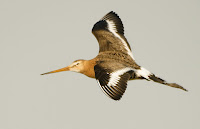BLACK-TAILED GODWIT
BLACK-TAILED GODWIT – (Limosa limosa) (See images below)
DESCRIPTION: The Black tailed Godwit is a wader with a long neck and bill, and long legs. Breeding adults have a dark orange breast and neck, which is more intense in the male. The head is brown with faint stripes. The body is mottled light brown and the wings are brown with a wide white bar across them. The tail, as the bird’s name implies, is black on its edge and white near the rump. The bill in the adults is orange near the base during the breeding season, with a black tip. The legs are grey. Juveniles are mottled brown with duller orange breasts and necks. The bird measures approximately 40 cm (16 inches) long.
VOICE: https://www.xeno-canto.org/species/Limosa-limosa
NAME: The English name ‘Godwit’ possibly refers to the bird’s call. The Latin name ‘Limosa’ refers to ‘muddy’, the habitat where this species forages.
HABITAT: Wetlands, bogs and damp fields.
DIET: Insects, larvae, spiders and other arthropods, crustaceans, fish eggs and tadpoles.
NESTING: These godwits nest in loose colonies. The nest is a scrape on the ground. Around three to five green eggs are laid, which are incubated by both parents.
DISTRIBUTION: The black-tailed godwit’s breeding range covers Iceland, much of Europe and central Asia. This bird is a long-distance migrant for the winter, and can be found as far south as Indonesia and Australia for that season. Some vagrants have also reached Hawaii. (See note below on bird vagrancy).
DISTRIBUTION MAP: https://en.wikipedia.org/wiki/Black-tailed_godwit#/media/File:LimosalimosaWorldDistribution.jpg
ON PEI: There are no reports of breeding on Prince Edward Island for this bird, and only accidental occurrences (vagrants) have been reported so far on the island (in the fall and winter).
CONSERVATION: The black-tailed godwit is listed as ‘near-threatened’ by the IUCN. This is because its population has declined rapidly in some of its overall range due to its wetland habitat being drained for agriculture.
NOTES: This is a colonial bird that can be found in large flocks.
Vagrancy: In biology this means an animal going way outside its normal range. For birds, this can happen when there are storms and they get blown off course. On other times, the bird simply wanders in a different direction than usual. Here’s an article about vagrancy in birds.
SIMILAR SPECIES: Hudsonian Godwit
REFERENCES: https://en.wikipedia.org/wiki/Black-tailed_godwit
https://identify.whatbird.com/obj/978/overview/Black-tailed_Godwit.aspx
https://www.rspb.org.uk/birds-and-wildlife/wildlife-guides/bird-a-z/black-tailed-godwit
https://www.birdlife.org/europe-and-central-asia/news/black-tailed-godwit-rebounds-sweden
DESCRIPTION: The Black tailed Godwit is a wader with a long neck and bill, and long legs. Breeding adults have a dark orange breast and neck, which is more intense in the male. The head is brown with faint stripes. The body is mottled light brown and the wings are brown with a wide white bar across them. The tail, as the bird’s name implies, is black on its edge and white near the rump. The bill in the adults is orange near the base during the breeding season, with a black tip. The legs are grey. Juveniles are mottled brown with duller orange breasts and necks. The bird measures approximately 40 cm (16 inches) long.
VOICE: https://www.xeno-canto.org/species/Limosa-limosa
NAME: The English name ‘Godwit’ possibly refers to the bird’s call. The Latin name ‘Limosa’ refers to ‘muddy’, the habitat where this species forages.
HABITAT: Wetlands, bogs and damp fields.
DIET: Insects, larvae, spiders and other arthropods, crustaceans, fish eggs and tadpoles.
NESTING: These godwits nest in loose colonies. The nest is a scrape on the ground. Around three to five green eggs are laid, which are incubated by both parents.
DISTRIBUTION: The black-tailed godwit’s breeding range covers Iceland, much of Europe and central Asia. This bird is a long-distance migrant for the winter, and can be found as far south as Indonesia and Australia for that season. Some vagrants have also reached Hawaii. (See note below on bird vagrancy).
DISTRIBUTION MAP: https://en.wikipedia.org/wiki/Black-tailed_godwit#/media/File:LimosalimosaWorldDistribution.jpg
ON PEI: There are no reports of breeding on Prince Edward Island for this bird, and only accidental occurrences (vagrants) have been reported so far on the island (in the fall and winter).
CONSERVATION: The black-tailed godwit is listed as ‘near-threatened’ by the IUCN. This is because its population has declined rapidly in some of its overall range due to its wetland habitat being drained for agriculture.
NOTES: This is a colonial bird that can be found in large flocks.
Vagrancy: In biology this means an animal going way outside its normal range. For birds, this can happen when there are storms and they get blown off course. On other times, the bird simply wanders in a different direction than usual. Here’s an article about vagrancy in birds.
SIMILAR SPECIES: Hudsonian Godwit
REFERENCES: https://en.wikipedia.org/wiki/Black-tailed_godwit
https://identify.whatbird.com/obj/978/overview/Black-tailed_Godwit.aspx
https://www.rspb.org.uk/birds-and-wildlife/wildlife-guides/bird-a-z/black-tailed-godwit
https://www.birdlife.org/europe-and-central-asia/news/black-tailed-godwit-rebounds-sweden
 |
| Black-tailed godwit, Iceland June 17, 2017, Roberta Palmer |
 |
| Black-tailed godwit in flight Uitkerkse Polders, Belgium (public domain) |